BY | DEC 7, 2009
“The mission of Apollo 8, quite apart from its significant scientific meaning, stimulated an immense rejuvenation of the spirit of mankind, and that spirit needed rejuvenation. A year featured by two grim assassinations [MLK and RFK], by riots, by racial and social strife, and a baffling attempt to end the war left men with a dull sense of frustration. Then at the end of such a year came the Apollo 8, an incredible adventure.” – Dr. Norman Vincent Peale, 33° Scottish Rite Freemason
Apollo 8 was the last Apollo flight to leave the ground during the Johnson administration. A decade before the launch, LBJ had laid out America’s goals in the space race, and none of them had much to do with sending men to the Moon: “Control of space means control of the world. From space, the masters of infinity would have the power to control Earth’s weather, to cause drought and flood, to change the tides and raise the levels of the sea, to divert the gulf stream and change the climates …”
I thought it was global warming that was supposed to be causing most of that, but I guess that is a bit off-topic.
To anyone paying close attention in the 1960s, the ridiculously improbable flight of Apollo 8 should have sent a clear signal that the Apollo Moon missions were going to be seriously lacking in credibility. Launched on the winter solstice of 1968, Apollo 8 was only the third launch of a Saturn V rocket, and the first to carry a crew. The first two Saturn V launches, Apollo 4 and Apollo 6, were what NASA referred to as “all-up” tests of the three-stage launch vehicle. Those tests didn’t go so well.
The team of rocket scientists who had developed the F-1 and J-2 rocket engines that powered the flights – most of whom were former Nazis recruited through Project Paperclip and relocated first to White Sands and then to the Marshall Space Flight Center in Huntsville, Alabama (one of the best sources of information on this is Linda Hunt’s Secret Agenda, St. Martin’s Press, 1991; see also Tom Bower’s The Paperclip Conspiracy, Little, Brown, 1987) – had assumed that each stage of the craft would be tested separately. They were reportedly horrified to find that NASA was bypassing such tests and proceeding directly to an ‘all-up’ test of Apollo 4 – but probably not nearly as horrified as the American people would have been had they known the truth about the past lives of NASA’s rocket scientists.
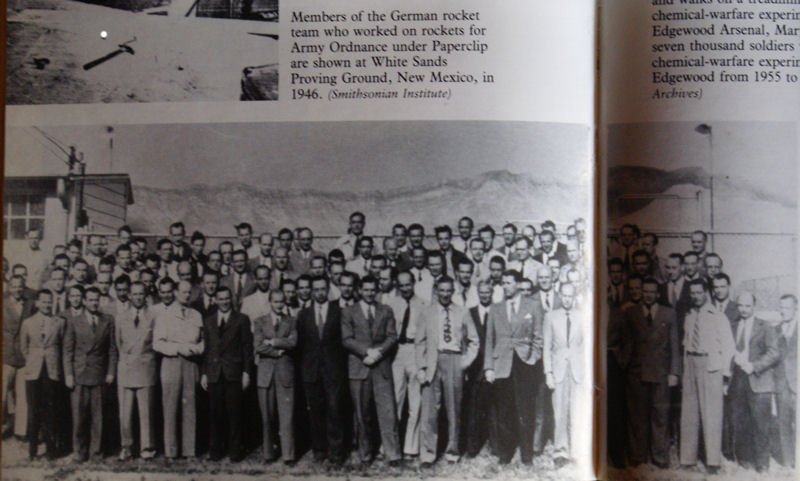
Nevertheless, the launch of Apollo 4, the very first Saturn V launch, was allegedly a smashing success. That claim seems rather dubious, however, given that the next all-up test, of Apollo 6, was marked by multiple malfunctions. The first-stage burn had serious vibration problems, and two of the second-stage’s five engines cut out, throwing the ship seriously off course.
According to Moon Machines, NASA was undeterred by the serious problems encountered during the flight of Apollo 6: “Despite the near loss of Apollo 6, NASA was pushing ahead with Apollo 8, the third flight of the Saturn V and the first to carry a crew.” NASA was so confident, in fact, that they decided to throw caution to the wind and swing for the fence with Apollo 8: “The third flight of the Saturn V would carry astronauts not to orbit the Earth, as everyone had expected, but to orbit the Moon.”
Had the Apollo program been a real space exploration endeavor, the first manned flight of the Saturn V would obviously have gone no further than low-Earth orbit, as had been planned. This would likely have been followed by an unmanned flight to the Moon, and then possibly a flight ‘piloted’ by a dog or some other such mammalian life form. But taking logical, methodical steps toward achieving goals in space was for those pussies over in Russia. America was going to take the John Wayne approach.
Without taking any of the preliminary steps, and with a launch vehicle that had failed on its last outing, and without knowing if the ship itself could make the journey there and back, America was going to send men all the way to the Moon!
Not to worry though: NASA was confident that all the problems with Apollo 6 had been diagnosed and fixed, and in record time. Despite the fact that the failed stages of the aircraft weren’t available for inspection, NASA’s crack team was able to expertly pinpoint and correct all the deficiencies so thoroughly that the new and improved Saturn V rocket didn’t even need a test flight to be sure it was working correctly. Indeed, it was ready to go all the way to the Moon!
Given America’s track record in the space race, which from the very beginning was marked by disappointments and desperate attempts to keep up with the Joneses, it was a seriously ballsy move. Following the October 4, 1957 launch of Sputnik I, a 184-pound Soviet satellite, the U.S. attempted to respond by launching Vanguard, a 3-pound sphere roughly the size of a large grapefruit, on December 6, 1957. With the nation nervously looking on, Vanguard rose approximately five feet from the launch pad before blowing up in a blaze of glory.
The U.S. had better luck on January 31, 1958, when it officially entered the space race with the successful launch of Explorer 1, a 31-pound satellite. The Soviets, meanwhile, had already successfully launched Sputnik III, a nearly 3,000-pound satellite described in Time-Life’s To the Moon as an “orbiting space laboratory.” America clearly had some catching up to do.
Once NASA’s engineers turned their attention to the Moon as a target of unmanned space flights, ‘disappointment’ continued to be the operative word. Beginning in August of 1961, the United States began attempting to crash-land an unmanned craft onto the Moon through the Ranger program. The first six such attempts failed. Ranger 1 and Ranger 2 both failed on the launch pad, Ranger 3 launched successfully but missed the Moon, Ranger 4 became disabled and drifted about aimlessly, Ranger 5 also shut down and missed the Moon, and the cameras aboard Ranger 6 failed, rendering it useless.
Finally, on July 31, 1964, nearly three full years after the first launch, Ranger 7 successfully impacted and photographed the Moon. Rangers 8 and 9 followed in February and March of 1965. The three successful probes gathered a combined total of roughly 17,000 images, which didn’t change the fact that the Ranger program overall had a 67% failure rate.
The next year, NASA launched two new lunar reconnaissance programs: Surveyor and the Lunar Orbiter Program. The first Surveyor blasted off on May 30, 1966, with six more to follow, the last on January 7, 1968. The goal of the program was to attempt ‘soft landings’ on the lunar surface. Two of the missions, Surveyor 2 and Surveyor 4, crashed, leaving the program with roughly a 29% failure rate. The Surveyor and Ranger programs had a combined failure rate of 50%.
NASA had much better luck with the Lunar Orbiter Program, which involved putting five satellites into lunar orbit between August of 1966 and August of 1967. Each of the five orbited the Moon, capturing high-resolution images, for an average of ten days each. In addition to mapping the lunar surface, the Orbiters also sent back the first images of Earth from space and the first photos of the Earth rising over the lunar horizon. In all, some 3,000 images were beamed back – officially at least.
The problem here, of course, is that NASA’s numbers don’t seem to add up. Does it make any sense at all that the three successful Ranger missions, which flew directly to the Moon and immediately crashed, sent back 17,000 images, and yet the five Orbiters, which spent a combined total of fifty-three days orbiting the Moon, sent back just 3,000 images? That’s a capture rate of just over two images per hour. And the Orbiters had multiple cameras on board.
There is little doubt that the Orbiters returned far more images than claimed, of which only a select few (relatively speaking) were released. What then happened to the rest of them? I’m going to go way out on a limb here and guess that NASA needed those images for another, more important project: faking the Apollo Moon landings. All of those glorious shots of Earth from space, and of Earth-rises, and of superimposed spacecraft in lunar orbit were undoubtedly created from unreleased imagery captured by the Orbiters. As were, no doubt, the fake lunar sets and the fake lunar backdrops.
One final note on the Lunar Orbiters: during their flights to and around the Moon, the five satellites recorded twenty-two “micrometeoroid events.” The eight lunar modules that made the trip to the Moon apparently recorded no such events. Or maybe the guys just put some duct tape over the holes.
Meanwhile, NASA’s manned space programs were having trouble as well. In the beginning, of course, there were the Mercury 7, the nation’s first space-age celebrities. Immortalized in The Right Stuff, the first seven astronauts were hand-picked from among hundreds of the nation’s finest fighter pilots. Six of those seven – Alan Shepard, Gus Grissom, John Glenn, Scott Carpenter, Wally Schirra, and Gordo Cooper – would become the first Americans in space, but for most of them it would not be an entirely smooth ride.
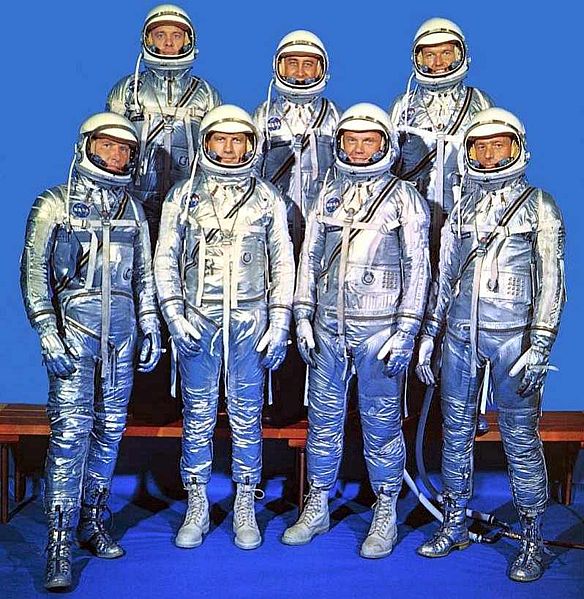
Shepard was the first to take flight aboard the Freedom 7, launched on May 5, 1961. His was an uneventful, 15-minute sub-orbital flight. Grissom followed on July 21, 1961 in the Liberty Bell 7, and things didn’t go so well for him. As with Shepard, his was just a sub-orbital flight, but it nearly cost him his life. Immediately after splashing down, the hatch blew on his capsule and it began taking on water. Grissom got free, but his suit, which was supposed to serve as a floatation device, also began taking on water, pulling him under.
Grissom’s plight did not improve with the arrival of a rescue helicopter, which concentrated exclusively on trying to save the capsule, ignoring the struggling Grissom who now also had to contend with the helicopter’s rotor wash. Grissom was pulled to safety only when a second rescue helicopter arrived. The capsule sunk to the bottom of the sea, three miles below.
Glenn was up next, and he was slated to be the first American in orbit. Riding aboard the Friendship 7, launched on February 20, 1962, Glenn did indeed make it into orbit, but NASA was not at all sure that they were going to be able to get him back. The launch had been delayed for a month as NASA worked out various problems, but there was still a serious glitch: during Glenn’s second orbit, technicians on the ground determined that the heat shield, essential for reentry, had come loose.
Glenn’s capsule was seriously damaged during reentry, but he survived unharmed and became an instant national hero.
Next up was Carpenter, who orbited the Earth three times aboard the Aurora 7 on May 24, 1962. Running low on fuel, Carpenter barely made reentry, and the wrong angle of reentry caused him to splash down some 250 miles off course and out of radio contact. It took rescue crews three hours to find him floating in the Atlantic. Some on the ground blamed Carpenter for the mishap, claiming that he had wasted fuel by acting like a tourist trying to see all the sights (you can’t really fault the guy for that – he was probably wishing that he had rolled a fatty to bring along).
Schirra was up to bat next, and he blasted off on October 3, 1962 aboard the Sigma 7, completing six orbits in just over nine hours. His was the first flight since Shepard’s, and the first orbital flight, to be free of any significant malfunctions.
The final Mercury flight was helmed by Cooper, who lifted off on May 15, 1963 inside the Faith 7 capsule. Cooper completed 22 orbits and was the first American to sleep in space. Problems arose in the final hours, however, when the capsule’s automatic controls failed and Cooper had to execute the first fully manual reentry. It would be nearly two years before the next Americans followed Cooper into space.
Overall, the Mercury program was largely a success in the sense that everyone made it back alive and well, but America had a very long way to go to get men to the Moon.
Next up was the Gemini program, featuring a larger, two-man capsule. Gemini, which ran from March of 1965 until November of 1966, had very specific goals: testing man’s ability to survive in space for up to two weeks; testing rendezvous and docking procedures; performing EVAs (space-walks); and making orbital adjustments. All of these were to be practiced until they became almost second nature.
The Gemini capsules were launched into orbit with Titan rockets, which proved to be a bit unstable at first. The first launch attempts blew up on the pad. Eventually NASA successfully launched two that didn’t blow up, and those were christened Gemini 1 and Gemini 2. Those were followed by ten manned Gemini flights, beginning with Gemini 3 launched on March 23, 1965, and concluding with Gemini 12, which took flight on November 11, 1966.
The flight of Gemini 3 was a short one – completing three orbits in just under five hours. Due to an equipment malfunction, pilots Gus Grissom and John Young had to manually control their reentry and splashed down some sixty miles off target. Other than that, the first manned Gemini mission was successful. Gemini 4, launched on June 3, 1965, remained in orbit for just over four days and featured the alleged space-walk by Ed White (NASA’s photos of which are, needless to say, spectacular).
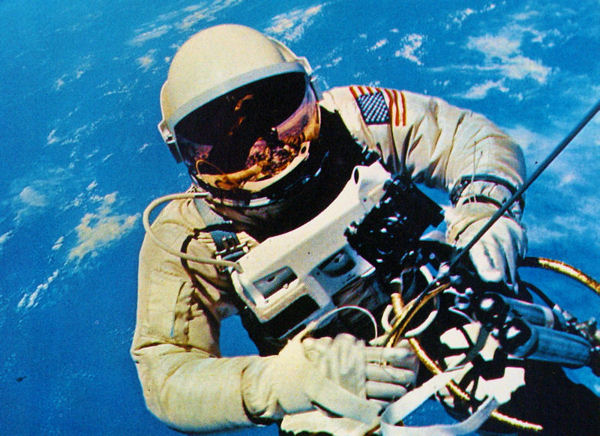
After a successful lift-off on August 21, 1965, Gemini 5 remained in low-Earth orbit for nearly eight days, completing 120 orbits. The flight was largely successful, though a malfunctioning fuel cell and faulty thrusters did cause some problems for the crew.
Upon their return, it should be noted, the Gemini 5’s pilots, Gordo Cooper and Pete Conrad, looked tired, haggard and unshaven, with their hair greasy and matted. In other words, they looked exactly as you would expect guys who had just spent a week in a cramped spaceship with no means of attending to basic matters of hygiene to look. Below, left to right, are photos of Conrad after returning from his eight-day mission, Lovell after returning from a four-day mission aboard Gemini 12, and Lovell again toward the end of his fourteen-day flight on Gemini 7.

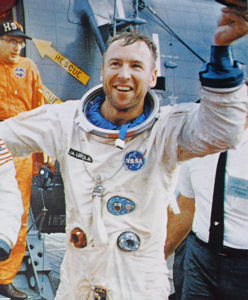

The Apollo astronauts, on the other hand, all arrived home looking rested, shaved and fresh faced, as though they had just returned from a day at the spa. Apparently they found room to include a shower and various other amenities on those Apollo spacecraft.
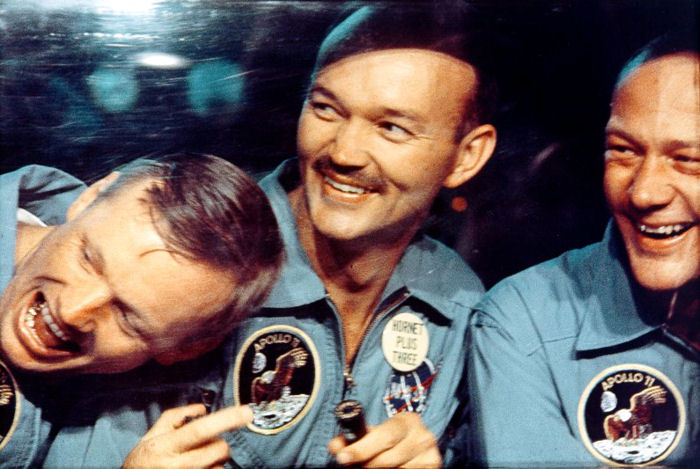
The next scheduled launch was Gemini 6, set to take flight in late October of 1965. The flight was postponed, however, due to the failure of an unmanned Agena craft launched as a docking target. On December 4, Gemini 7, with Frank Borman and Jim Lovell on board, began a grueling fourteen-day stay in low-Earth orbit. About a week later, Gemini 6 was once again ready for launch, but that launch was aborted when an engine shut down, narrowly averting a fatal explosion on the pad.
Gemini 6 finally got into low-Earth orbit on December 11 and remained there for just over one day. During that time, Gemini 6 allegedly performed a rendezvous maneuver with Gemini 7, the two spacecraft remaining side-by-side for some 5.5 hours while traveling at 17,000 miles per hour. Curiously, there was a launch of a military rocket in between the launches of Gemini 6 and Gemini 7, and Lovell has said that that launch was connected in some unspecified manner to the mission of Gemini 7.
Gemini 8, helmed by Neil Armstrong and David Scott, blasted off on March 16, 1966. The goal of the mission was to test rendezvous and docking procedures and to achieve the first successful docking between a Gemini capsule and an unmanned Agena craft. Curiously, the two pilots chosen for this complex mission were both rookies. The crew that had originally been slated to fly the mission, Elliot See and Charles Bassett, were killed on February 28, 1966, just days before the launch, when See, one of the nation’s top pilots, slammed a T-38 Talon into the side of a building in St. Louis.
Gemini 8 reportedly succeeded in docking with the Agena target, but trouble began almost immediately. The conjoined spacecraft began to tumble violently end-over-end, forcing Armstrong to jettison the Agena. That, however, only caused the Gemini capsule to tumble even more violently. Armstrong finally had to resort to firing the rockets used for reentry positioning to stabilize the craft, which necessitated immediately aborting the mission. The capsule splashed down in the Pacific, a half-a-world away from its target in the Atlantic.
On June 3, 1966, Gemini 9, piloted by Tom Stafford and Gene Cernan, took flight. The launch had been postponed due to the failure of another Agena target. The goal was, once again, to dock with an unmanned Agena craft. That docking failed to materialize, however, when yet another Agena target malfunctioned. This was also the flight on which Cernan took his nearly fatal space-walk (there was debate on the ground over whether he should be cut loose to drift in space or left tethered to burn up upon reentry if he couldn’t make it back in).
Following Gemini 9, there were only three manned Gemini missions left and the United States had thus far failed to come anywhere close to mastering either docking procedures or EVAs, both of which would be absolutely essential for the success of the proposed Apollo missions.
Gemini 10, with John Young and Michael Collins at the wheel, lifted off on July 18, 1966 and remained in orbit for just under three days. Young and Collins reportedly achieved the first successful, stable docking of a Gemini capsule with an Agena target. Collins also performed a largely unsuccessful EVA, though not as disastrous as Cernan’s on the previous flight.
Gemini 11, piloted by Charles Conrad and Richard Gordon, took to the skies on September 12, 1966 and, like Gemini 10, remained in orbit for just under three days. And like Gemini 10, the mission included a docking maneuver with an Agena target and a less than fully successful space-walk (by Gordon).
The final Gemini mission, Gemini 12, put Jim Lovell and Buzz Aldrin into low-Earth orbit for just under four days. Aldrin completed the first fully successful space-walk and the two pilots once again practiced docking with an Agena target. NASA had come a long way since shooting Alan Shepard out of a cannon in May of 1961, but the Moon still seemed like a far-off goal. The progression from Mercury to Gemini – from a single-occupancy capsule to a somewhat more sophisticated, double-occupancy capsule, requiring a somewhat larger launch vehicle – was a natural one. NASA’s next step, however, was going to be more of a quantum leap.
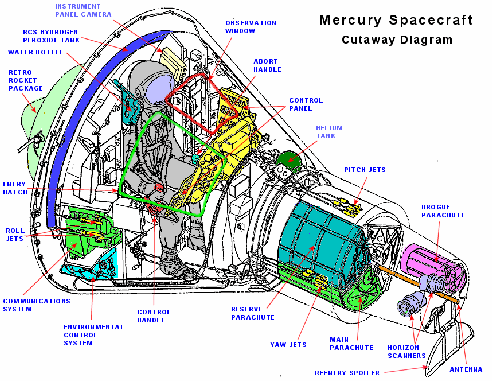

The Saturn V rocket bore little resemblance to any previous launch vehicles. As Apollo flight director Gene Kranz observed, “It was a new spacecraft. It was something that we had to learn from the ground up – that we had to learn from scratch.” It was a massive, and massively complex, spacecraft. The Saturn V was so much larger than its predecessors that all previous manned launch vehicles – the six Mercury and ten Gemini vehicles – could fit inside a single Saturn V casing.
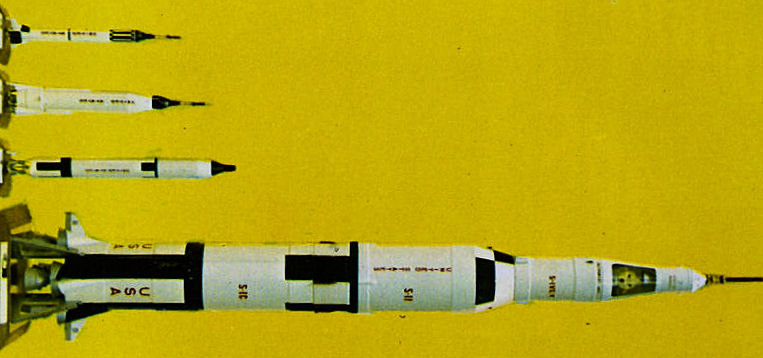
A fully assembled, launch-ready Saturn V stood 363 feet tall and weighed in at roughly 6,000,000 pounds, 90% of which was fuel weight. Depending upon who is telling the story, it contained either 6,000,000 or 9,000,000 parts. There were three disposable launch stages, atop which sat the lunar, service and command modules, which was then capped with a launch escape system that was jettisoned shortly after lift-off.
The 138-foot tall first stage featured five massive F-1 rocket engines, each of which consumed three tons of fuel per second. They were fed by a 331,000-gallon tank of liquid oxygen and a 203,000-gallon tank of refined kerosene, all of which was consumed in just two-and-a-half minutes, generating some 7,500,000 pounds of thrust (160,000,000 horsepower).
After that first stage fell away, at an altitude of approximately thirty-five miles, the 82-foot long second stage, powered by five J-2 rocket engines, took over. The J-2s burned a combination of liquid oxygen and liquid hydrogen, propelling the ship to an altitude of 115 miles. After the second stage dropped away, the 61-foot long third stage, powered by a single J-2 engine, took over, putting the spacecraft into low-Earth orbit.
As Time-Life noted, the third stage “will not be jettisoned at this time; instead, three hours later it will be restarted to fire the Apollo toward the moon. At 10,350 miles from Earth, the command module, powered by its service module, will separate from the third stage, make a half-circle turn back toward the third stage, as the lunar module shroud of the third stage opens. The command module will dock with the lunar module, which is to ferry the astronauts between the command module and the moon, then back it free of the third stage. After completing another half-circle turn, the two modules, nose to nose, will head toward the moon.”
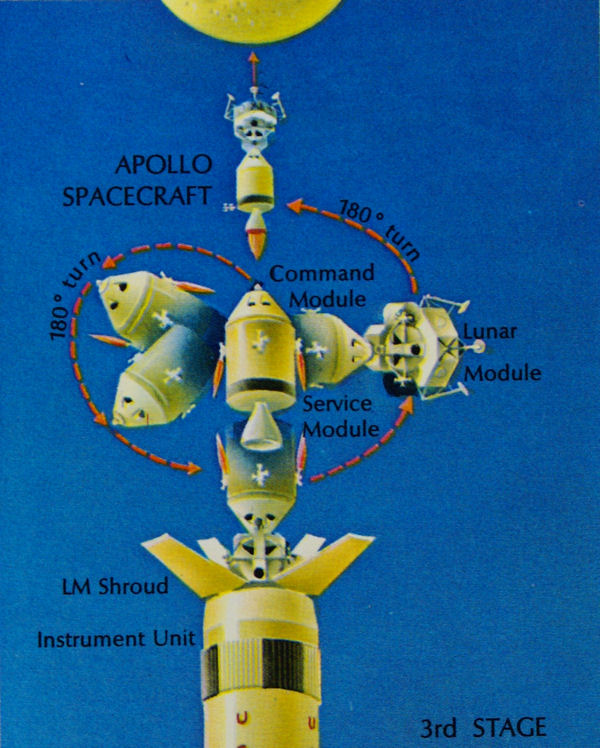
Sounds easy enough. I can see why they were able to nail it every single time, unlike the problems they had with those troublesome Agena craft. Time-Life also fills us in on the details of the “probe and drogue” docking mechanism: “The probe, a 10-inch cylinder extending from the nose of the command module, must be inserted into a cone-shaped receptacle, the drogue of the LM … As the probe finds its mark, automatic spring latches lock the two together. The whole probe-and-drogue assembly will be removed, clearing the tunnel through which [the astronauts] will enter the LM. Inside the command module, [the command module pilot] flips a switch that frees the LM.”
Pictured below are the command module’s docking probe, the LEM’s drogue (with the LEM allegedly in Earth orbit on the alleged Apollo 9 mission, in yet another spectacular shot from NASA’s collection), and a close up of how the mechanism was supposed to work. Curiously left unexplained was how, with the probe-and-drogue assembly having been removed, the LEM was able to dock with the command module the second time, upon its return from the lunar surface.
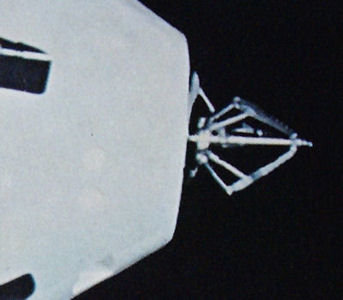
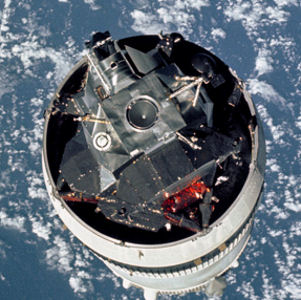
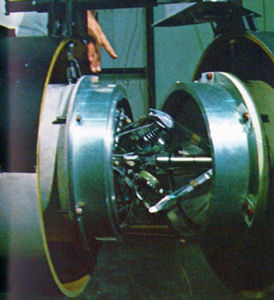
I am sure though that the pud-pullers over at the BAUT forum will be able to explain it. Maybe they can also explain why it is that the space shuttle never went to the Moon. I was thinking about that the other day as I was reading another heaping pile of ‘debunker’ blather about how, once you’re into low-Earth orbit, 90% of the work of getting to the Moon is already done.
The ‘debunkers,’ you see, claim that comparing the distance astronauts travel into space today (200 miles) with the distance they traveled back in the magical 1960s (234,000 miles) is entirely unfair because it is, as any fool knows, during that first 200 miles that all the heavy lifting is done. Once you’re in low-Earth orbit, it is a fairly easy matter to briefly fire the engines and ‘slingshot’ out of orbit and set a course for the Moon. And getting back is just as easy – just ‘slingshot’ around the Moon and cruise on back to Earth. It hardly even requires any fuel. It’s just a matter of, you know, falling through the void of space.
If that is the case, however, then how come none of the space shuttles, during the more than a quarter-century that the program has been in operation, has ever done a fly-by of the Moon? The Apollo 13 crew allegedly made the flight in a lunar module composed of Popsicle sticks and Scotch tape, and yet the obviously vastly more sophisticated space shuttle can’t make it there and back? Really?!
Why couldn’t it, on any one of its missions, have just used the old ‘slingshot’ approach to go to the Moon and back? And please, let’s not trot out the old “there was no reason to do that as there was nothing to gain” excuse, because that is clearly a complete load of horseshit. The space shuttle is far better shielded than the Apollo craft were, it carries plenty of fuel and plenty of provisions to last for the duration of the trip. Indeed, today’s astronauts should be able to travel to the Moon and back in relative comfort.
So why has it never been done? Apollo 8 did it all the back in 1968, which I started to talk about at the top of this post, before getting hopelessly sidetracked. More on that next time.
No comments:
Post a Comment